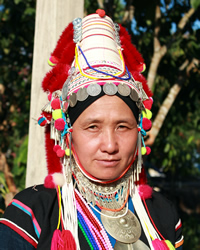Akha in Myanmar (Burma)

Photo Source:
Arian Zwegers - Flickr
Creative Commons
|
Send Joshua Project a map of this people group.
|
| People Name: | Akha |
| Country: | Myanmar (Burma) |
| 10/40 Window: | Yes |
| Population: | 222,000 |
| World Population: | 625,000 |
| Primary Language: | Akha |
| Primary Religion: | Ethnic Religions |
| Christian Adherents: | 30.00 % |
| Evangelicals: | 15.00 % |
| Scripture: | Complete Bible |
| Ministry Resources: | Yes |
| Jesus Film: | Yes |
| Audio Recordings: | Yes |
| People Cluster: | Hani |
| Affinity Bloc: | Tibetan-Himalayan Peoples |
| Progress Level: |
|
Identity
The Akha possess their own language, rich culture, and unique dress, which makes them highly visible in each country they inhabit. They have been counted as a separate ethnic group in Myanmar for well over a century. The 1901 census returned 27,526 Akha people, a figure that increased to 40,405 in 1931. The Akha are called a host of names by other ethnicities in the region. Some names, like Ekaw and Kho, are considered derogatory by the Akha.
Location: More than 220,000 Akha people inhabit countless small villages at high elevations in northeast Myanmar's Shan State. They are concentrated in the eastern part of Kengtung District and in all three townships of Tachileik District, bordering Laos and Thailand. Most Akha live in Yunnan Province, China, while significant populations are also scattered throughout the mountains of Laos (123,000), Thailand (80,000), and Vietnam (23,000).
Language: Akha, which is part of the Tibeto-Burman language family, consists of several dialects so divergent that people from the different dialect groups struggle to understand one another. A Roman orthography was created for the Akha in 1950 and has been in use among them ever since.
History
The Akha possess a detailed creation poem, and an ancient flood legend that recalls how everyone in the world perished except a brother and sister. Some accounts say they survived by riding in a giant gourd, while other versions say it was a large drum. An Akha myth states that “humans and spirits once lived in harmony on earth, with humans tilling the fields during the day and the spirits doing so at night. Trouble broke out when the spirits began to steal eggs from humans, and humans began to steal cucumbers from the spirits. The Akha built spirit gates at the entrances to all their villages, to separate the realm of the spirits from that of humans."
Customs
Akha history and culture is transferred from generation to generation by long recitations, which are committed to memory and shared in group settings. It is important for an Akha to be able to recite the complete genealogy of more than 60 generations, right back to the first man, Sm Mi O. To be unable to do so is considered a disgrace. Despite being some of the poorest people in Asia, Akha women have a striking appearance, wearing heavily decorated headdresses and skirts.
Religion
Although they believe in a supreme deity named Apoe Miyeh, Akha religion is “a mixture of animism and ancestor worship that emphasizes the connection with the land and their place in the natural world and cycles.” Today most Akha continue to observe animist rituals, while some who live near Buddhist neighbors have converted to their religion. Christianity has also gained a significant foothold, although followers of Christ are often ostracized from their communities and forced to move to Christian-only Akha villages.
Christianity
In 1910 it was remarked: "The Akhas are not as ready to embrace the Christian faith as the Lahu." By the time of the 1931 census, however, 656 Akha people in Myanmar (1.6 percent of the population) were Christians, the firstfruits of what would ultimately become a bountiful harvest. Today an estimated 30 percent of Akha in Myanmar are professing Christians, while in Thailand more than half of the Akha have converted to Christ. Missionaries have been active among the Akha since the late 19th century, and although the Akha Bible has been available since 2001, Animism is such a deeply embedded feature of Akha life that many believers struggle to break free and have mixed biblical Christianity with traditional Akha beliefs.